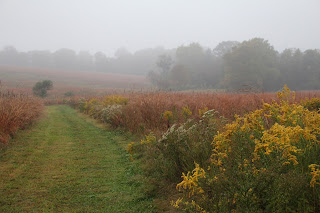For the last two days, a front has stalled over the northern Piedmont. While we've had showers off and on, the front's most dramatic effect has been to envelope us in a soft, gauzy fog.
Last night, after an early dinner, enough light remained to entice me out into the fields to capture some of the muted landscape.
In some places, goldenrod (Solidago spp.) blooms are past their prime and beginning to turn brown...
...but in other places, they're still going strong.
A friend of mine, a Welsh ex-pat named Keith Collins, haunts the preserve taking pictures, too. He shared some of his images from yesterday's foggy afternoon.
 |
| White-snakeroot (Ageratina altissima) and Indian-grass (Sorghastrum nutans) by Keith Collins |
 |
| Kaleidoscope of autumn wildflowers by Keith Collins |
 |
| Staghorn sumac leaves (Rhus typhina) by Keith Collins |








6 comments:
Lovely photos, Scott (and Keith). Some very English weather you're having.
John: September and October are typically our two driest months--but not this year!
Scott:
Nice photos! Your field is showing more color than my woods right now. At least as much as I can tell in all this fog.
Great shot of the Bumblebee, Scott. Is the black background natural or are you photoshopping now?
Actually, the color in the fields is fading now. Don't be so impatient, Carolyn; the fall color is coming!
Packrat: Thanks for the compliment about the bumblebee image. Actually, I was very surprised myself when I downloaded the image onto my computer and saw how dark the background was. I did SLIGHTLY enhance the contrast, but the raw shot really did look pretty much like you see it. I used a flash and got very close to the bee for the shot. I was afraid that the flash might disturb the bee, but it didn't move a muscle and sat patiently through two exposures.
Post a Comment